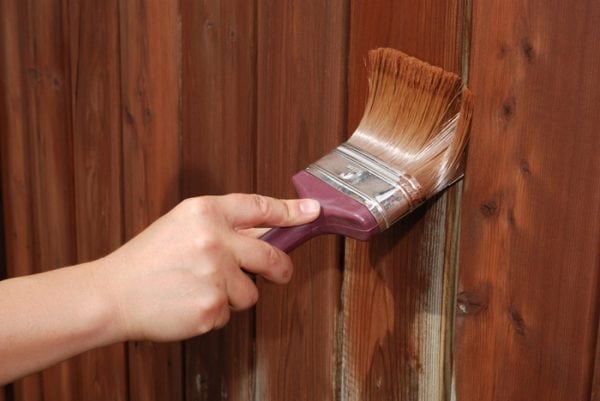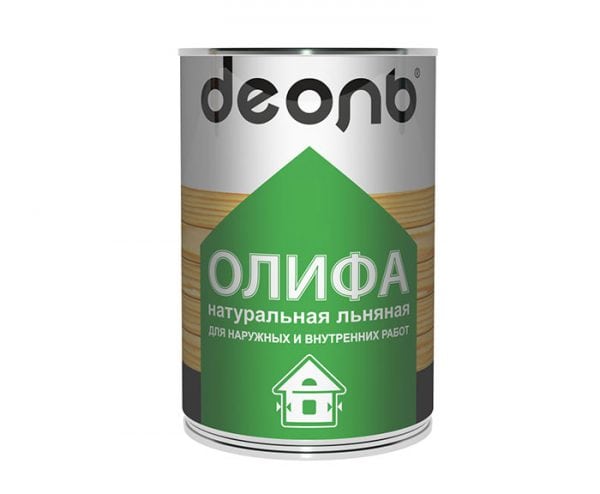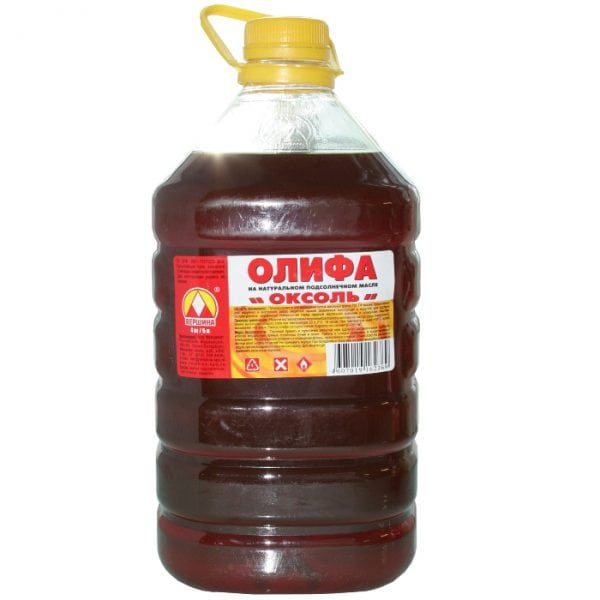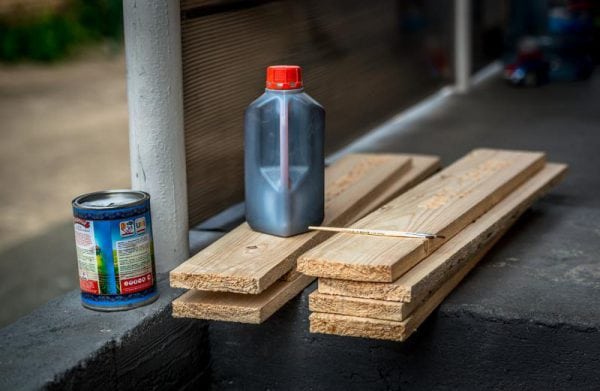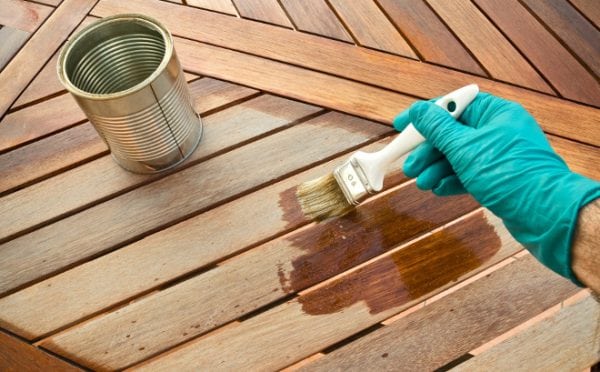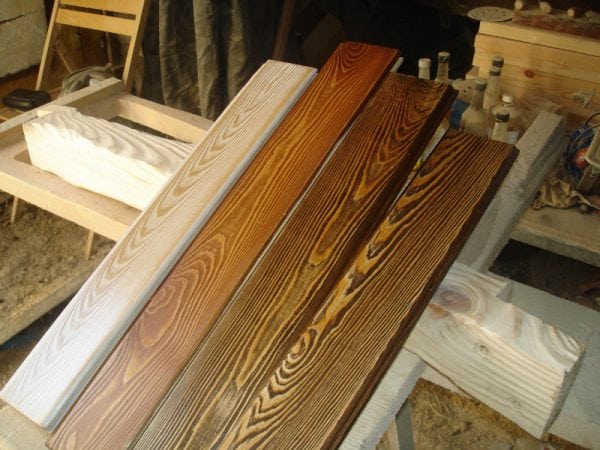Drying oil is a film-forming substance made from natural or artificial components. Drying oils are used as independent primers, as well as as one of the components of more complex compositions. In addition, drying oils can be used as an independent material for decorative and protective processing of wood.
- Varieties of varnish
- Natural compounds
- Semi-natural compounds
- Combined formulations
- Synthetic compounds
- Selection tips
- Surface treatment
- Application
- Drying
- Oliph replacement
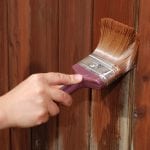
Varieties of varnish
Existing compounds can be divided into the following groups:
- natural;
- semi-natural;
- combined;
- synthetic.
Natural compounds
Natural type drying oils are made from vegetable oils. The compositions of this variety are made in accordance with the requirements of GOST 7931-76. The most suitable chemical substance is flaxseed oil, although hemp, sunflower or tung oil can also be used.
Natural drying oils contain only a very small percentage of chemical additives. The main component added to the impregnation is desiccant, which is a substance that accelerates the drying process.
For the treatment of facades, natural compounds are not practical to use because of the high financial costs. In addition, the treated surface will not be protected from fungus, mold and harmful insects.
Natural raw materials bred oil paintsprimed wood before applying paint and varnish. Also, natural compositions are used as a primer material and as a component of paint and varnish primers, putty, plaster compositions. Such drying oils are also used for surface treatment indoors.
The drying time of the composition, subject to the optimum air temperature (20 degrees above zero), is about a day. The lightest of all types of impregnation is sunflower, linseed is noticeably darker, and the darkest is hemp.
Compositions made from various raw materials have their own characteristics. For example, hemp drying oil is used to dilute dark paints of a thick-grated type.
Sunflower impregnations are distinguished by the longest drying time - 24 hours with optimal indicators of air temperature and humidity. Moreover, this is a minimum period, and in practice, even after a day, the surface will most likely remain slightly moist. Sunflower compounds have a strong side - increased elasticity. At the same time, according to such an important indicator as hardness, sunflower impregnations lose to flax and hemp varieties.
to contents ↑Semi-natural compounds
Semi-natural varnishes (oxols) are also made from oil (usually sunflower), but differ from natural compounds by the presence of a large amount of an organic solvent - white spirit. Its share reaches 40%. Semi-natural impregnations also include desiccants (about 5%). No semi-natural solutions of mineral oils and surrogates. The standard for the manufacture of this type of drying oil is GOST 190-78.
The scope of use of oxols is the same as that of natural compounds. Most often, semi-natural solutions are used for combination with oil paints or as a primer.Such drying oils are not suitable for surface treatment in a bath, but can be used, for example, for impregnating fiberboard, plywood, lining in drier rooms.
Semi-natural compounds dry slightly faster than natural ones, and material consumption is 1m2 less. In addition, the cost of their production is lower.
The color of the semi-natural impregnation is light brown. The film that appears on the surface of the processed material is characterized by hardness and good resistance to moisture. However, the strength of this type of drying oil is still not enough to use it for treating surfaces exposed to increased mechanical stress (for example, floors).
to contents ↑Combined formulations
Combined mixtures almost do not differ from semi-natural ones - this is a product of the polymerization of drying fats. However, the solvent in them is less (approximately 30%). The main advantage of combined formulations over semi-natural ones is less toxicity.. Combined impregnations often contain special modifiers that increase the quality required in the manufacture of paints and varnishes.
Combined drying oils are usually used as a primer before painting wooden surfaces. The drying time of the coating is up to 24 hours.
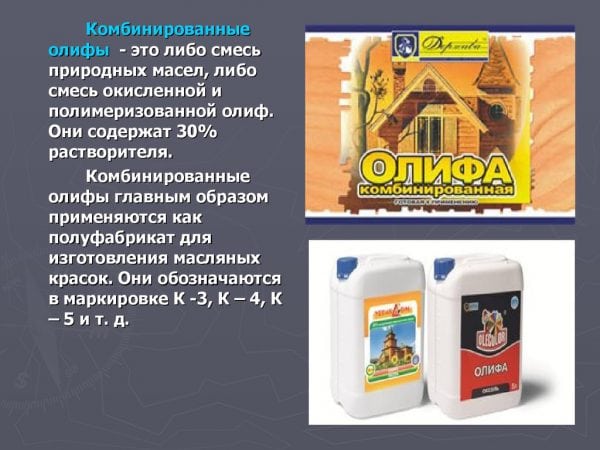
Synthetic compounds
Synthetic impregnations are made only from artificial components - polymers. The raw material for this type of drying oil is oil, coal or waste generated during the manufacture of synthetic rubber. A characteristic feature of synthetic solutions is a dark color and a sharp unpleasant odor.
Synthetics are practically not used as an impregnating substance for wood. Most often, synthetic drying oils are used in the cultivation of dark varieties of paints and varnishes used in facade work or as a component of putty and pastes. This is the lowest quality type of drying oil, which affects their cost.
Synthetic mixtures cannot be used for surface treatment inside buildings. Otherwise, a sharp smell will remain in the room for many months, and the people living there are at risk of intoxication.
Synthetics dry for a long time, and is also characterized by a variety of properties, depending on the components included in the mixture. For example, drying oils based on fusa (a liquid of red color with a dark precipitate) do not dry out at all, and if they cover the surface, the surface cannot be painted.
Osprey-based solutions dry very poorly, and when dry, the coating is a crumbling glass-like film. This impregnation is the most liquid, light and cheapest of all the options available on the market.
The best synthetic option is alkyd drying oil. It is less toxic compared to materials made from petroleum polymers. However, even this type of impregnating substance can only be used for finishing external surfaces.
to contents ↑Selection tips
Some useful tips when buying varnish:
- It is recommended to pay attention to the composition of the product (it is indicated on the packaging), and on compliance with GOST. The state standard (GOST) applies only to natural and semi-natural impregnations. The synthetics is supplied with a hygiene certificate.
- The fluid must be homogeneous, no deposits or mechanical particles should be at the bottom of the tank.
- Take a look at the transparency of the content. Natural drying oils are brown (of varying degrees of color saturation, depending on the type of base material). The color of synthetics also depends on the main component and can vary from a colorless liquid to dark red.
to contents ↑
Surface treatment
Before drying, the surface should be prepared.To do this, the wood must be degreased, remove dirt and dust from it. The material to be processed must be dry.
Application
You can apply the impregnation using several types of tools to choose from:
- brushes with a long pile;
- roller;
- spray gun;
- rags made of natural fabric.
Below are several ways to soak a tree with linseed oil:
- Hot impregnation. Impregnation is carried out in a water bath. The method is especially good for processing small products. We put the material in a vessel with a hot solution, holding it there for 4-8 hours, and then dry for 4-5 days. Useful advice: if you add to the composition red lead (2-3% of the total volume), the surface will dry much faster - in 2-3 days.
- Oil drying oil with kerosene. To create a mixture, we take these components in a ratio of 1 to 1. It is acceptable to use both hot and cold solution. However, the temperature of drying oil affects the time during which the wood must be aged. If we are talking about the hot method, it will take only 3 hours, but the cold version will require 1-2 days. The drying period of the coating is 2-3 days.
- Drying oil, paraffin and turpentine. We mix 5 parts of drying oil, 1 part of turpentine and 8 parts of paraffin. And first we dissolve the paraffin in turpentine, for which we use a water bath. Next, add the right amount of drying oil and mix thoroughly. We apply a hot composition to the tree and wait until it is completely dry (it will take 2-3 days).
- Drying oil with wax. For 20 parts of the base material, we take 3 parts of the wax, which we grind beforehand. The surface will dry in 2-3 days.
- Impregnation with a plastic bag. Take an intact bag, pour a little liquid into it. Next, we place a wooden part in the bag. We wrap the product by sealing the hole with tape. Soaking will take several hours.
During the impregnation, a sufficient amount of drying oil should be applied to the surface. The liquid should soak wood well. When the coating dries, apply a second coat. If necessary, the procedure can be repeated until the tree ceases to absorb the solution.
to contents ↑Drying
Drying speed depends on several factors, the main of which are the desiccant content, air temperature and humidity, as well as the type and quality of drying oil.
The fastest drying is impregnation with polymetallic desiccants. For example, natural linseed oil with the addition of a lead or manganese desiccant dries in 20 hours and 12 hours, respectively. However, it is worth using both of these metals, and the drying speed will not exceed 8 hours.
The drying time is directly affected by temperature and humidity. For example, to dry the impregnation with a cobalt desiccant, it will take 50% less time if the air temperature is at least 25 degrees above zero. Even faster (at least 2-3 times) dries the surface treated with the composition with the presence of a manganese desiccant. Favorable air humidity is also important, this figure should not exceed 70%.
After processing, the wooden part must be placed in a dry and warm place. There should be no drafts in the room. There is no need to specifically heat the surface, such actions can only do harm.
to contents ↑Advice! Drying oil is a fire-hazardous and toxic material, therefore, when working with it, you must observe safety precautions. For protection, it is recommended to use a bathrobe, goggles and a respirator. Impregnated containers should be stored away from fire, electrical and gas appliances.
Oliph replacement
If there is no drying oil at hand, the surface can be treated with a casein solution. Such a composition will be cheaper than factory impregnation, and its properties are no worse. In addition, casein solution dries much faster.
To prepare it, you will need 20 parts of casein, 3 parts of a soap solution and 10 parts of slaked lime. Stir the ingredients thoroughly and add 7 parts of turpentine. The consistency of the solution should resemble a thick drying oil. If a sediment appears at the bottom of the container, add a little ammonia to the composition.
Drying oil is an excellent substitute for more modern and expensive methods of impregnation and priming of wood. However, do not forget that not all types of impregnation are suitable for use in residential premises.

